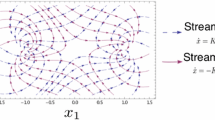Abstract
The theory of nonequilibrium potentials or quasipotentials is a physically motivated approach to small random perturbations of dynamical systems, leading to exponential estimates of invariant probabilities and mean first exit times. In the present article we develop the mathematical foundation of this theory for discrete-time systems, following and extending the work of Freidlin and Wentzell, and Kifer. We discuss strategies for calculating and estimating quasipotentials and show their application to one-dimensionalS-unimodal maps. The method proves to be especially suited for describing the noise scaling behavior of invariant probabilities, e.g., for the map occurring as the limit of the Feigenbaum period-doubling sequence. We show that the method allows statements about the scaling behavior in the case of localized noise, too, which does not originally lie within the scope of the quasipotential formalism.
Similar content being viewed by others
References
L. D. Landau and E. M. Lifshitz,Statistical Physics (Pergamon, Oxford, 1969).
R. Graham, Macroscopic potentials, bifurcations and noise in dissipative systems, inNoise in Nonlinear Dynamical Systems, Vol. 1, F. Moss and P. V. E. McClintock, eds. (Cambridge University Press, Cambridge, 1989).
A. D. Wentzell and M. I. Freidlin, On small random perturbations of dynamical systems,Usp. Math. Nauk 25:1, 3 (1970) [Russ. Math. Surv. 25:1, 1 (1970)].
M. I. Freidlin and A. D. Wentzell,Random Perturbations of Dynamical Systems (Springer, New York, 1984).
R. Graham and T. Tél, Nonequilibrium potential for coexisting attractors,Phys. Rev. A 33:1322 (1986).
R. L. Kautz, Thermally induced escape: The principle of minimum available noise energy,Phys. Rev. A 38:2066 (1988).
P. Grassberger, Noise-induced escape from attractors,J. Phys. A 22:3283 (1989).
Yu. Kifer,Random Perturbations of Dynamical Systems (Birkhäuser, Boston, 1988).
Yu. Kifer, Attractors via random perturbations,Commun. Math. Phys. 121:445 (1989).
M. L. Blank, Deterministic properties of stochastically perturbed dynamic systems,Theory Prob. Appl. 33:612 (1988).
P. Talkner and P. Hänggi, Discrete dynamics perturbed by weak noise, inNoise in Non-linear Dynamical Systems, Vol. 2, F. Moss and P. V. E. McClintock, eds. (Cambridge University Press, Cambridge, 1989).
P. Reimann, Stationäre Wahrscheinlichkeitsverteilungen für diskrete dynamische Systeme mit schwachem Rauschen, Diplomarbeit, Basel (1989), unpublished.
P. Reimann and P. Talkner, Probability densities for discrete dynamical systems with weak noise,Helv. Phys. Acta 63:845 (1990); and to be published.
R. L. Kautz, Global stability of the chaotic state near an interior crisis, inStructure, Coherence and Chaos in Dynamical Systems, P. L. Christiansen and R. D. Parmentier, eds. (Manchester University Press, Manchester, 1989).
P. D. Beale, Noise-induced escape from attractors in one-dimensional maps,Phys. Rev. A 40:3998 (1989).
R. Graham, A. Hamm, and T. Tél, Non-equilibrium potentials for dynamical systems with fractal attractors or repellers,Phys. Rev. Lett. 66:3089 (1991).
D. Ruelle,Elements of Differentiable Dynamics and Bifurcation Theory (Academic Press, San Diego, 1989).
J. Guckenheimer and P. J. Holmes,Nonlinear Oscillations, Dynamical Systems, and Bifurcation of Vector Fields (Springer, New York, 1983).
D. Ruelle, Small random perturbations of dynamical systems and the definition of attractors,Commun. Math. Phys. 82:137 (1981).
R. Graham and T. Tél, On the weak-noise limit of Fokker-Planck models,J. Stat. Phys. 35:729 (1984).
R. Graham and T. Tél, Weak-noise limit of Fokker-Planck models and nondifferentiable potentials for dissipative dynamical systems,Phys. Rev. A 31:1109 (1985).
H. R. Jauslin, Melnikov's criterion for nondifferentiable weak-noise potentials,J. Stat. Phys. 42:573 (1986).
R. Kubo, K. Matsuo, and K. Kitahara, Fluctuation and relaxation of macrovariables,J. Stat. Phys. 9:51 (1973).
H. Lemarchand and G. Nicolis, Stochastic analysis of symmetry-breaking bifurcations: Master equation approach,J. Stat. Phys. 37:609 (1984).
G. Hu and H. Haken, Polynomial expansion of the potential of Fokker-Planck equations with a noninvertible diffusion matrix,Phys. Rev. A 40:5966 (1989).
P. Collet and J.-P. Eckmann,Iterated Maps on the Interval As Dynamical Systems (Birkhäuser, Boston, 1980).
P. Holmes and D. Whitley, Bifurcations of one- and two-dimensional maps,Phil. Trans. R. Soc. Lond. A 311:43 (1984).
J. P. Crutchfield, J. D. Farmer, and B. A. Huberman, Fluctuations and simple chaotic dynamics,Phys. Rep. 92:46 (1982).
H. Haken and G. Mayer-Kress, Chapman-Kolmogorov equation and path integrals for discrete chaos in presence of noise,Z. Phys. B 43:185 (1981).
L. Jonker and D. Rand, Bifurcations in one dimension I,Invent. Math. 62:347 (1981).
J. Guckenheimer, G. Oster, and A. Ipaktchi, The dynamics of density dependent population models,J. Math. Biol. 4:101 (1977).
R. L. Devaney,An Introduction to Chaotic Dynamical Systems (Addison-Wesley, Redwood City, 1987).
E. B. Vul, Ya. G. Sinai, and K. M. Khanin, Feigenbaum universality and the thermodynamic formalism,Usp. Math. Nauk 39:3, 3 (1984) [Russ. Math. Surv. 39:3, l (1984)].
T. Bohr and T. Tél, The thermodynamics of fractals, inDirections in Chaos, Vol. 2, B.-L. Hao, ed. (World Scientific, Singapore, 1988).
J. Crutchfield, M. Nauenberg, and J. Rudnick, Scaling for external noise at the onset of chaos,Phys. Rev. Lett. 46:933 (1981).
B. Shraiman, C. E. Wayne, and P. C. Martin, Scaling theory for noisy period-doubling transitions to chaos,Phys. Rev. Lett. 46:935 (1981).
G. Mayer-Kress and H. Haken, The influence of noise on the logistic model,J. Stat. Phys. 26:149 (1981).
Z. Kovács, Universalf(α) spectrum as an eigenvalue,J. Phys. A 22:5161 (1989); and private communication.
J. H. Curry, L. Garnett, and D. Sullivan, On the iteration of a rational function: Computer experiments with Newton's method,Commun. Math. Phys. 91:267 (1983).
H.-O. Peitgen, D. Saupe, and F. v. Haeseler, Cayley's problem and Julia sets,Math. Intell. 6:2, 11 (1984).
Author information
Authors and Affiliations
Rights and permissions
About this article
Cite this article
Hamm, A., Graham, R. Quasipotentials for simple noisy maps with complicated dynamics. J Stat Phys 66, 689–725 (1992). https://doi.org/10.1007/BF01055697
Received:
Revised:
Issue Date:
DOI: https://doi.org/10.1007/BF01055697



